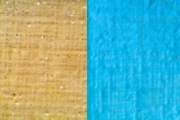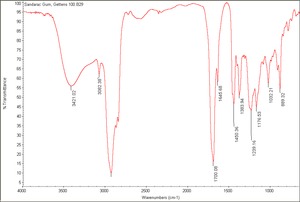Difference between revisions of "Sandarac"
(username removed) |
|||
| (4 intermediate revisions by 4 users not shown) | |||
| Line 1: | Line 1: | ||
| − | [[File:68-86_Sandarac.Spirit_canvas.jpg|thumb|Sandarac Spirit]] | + | [[File:68-86_Sandarac.Spirit_canvas.jpg|thumb|Sandarac Spirit on canvas<br>(visible light left; UV light right)]] |
== Description == | == Description == | ||
| − | + | [[File:26-39_Sandarac Oil_glass.jpg|thumb|Sandarac oil on glass<br>(visible light left; UV light right)]] | |
A pale yellow natural resin from the alerce tree ''Callitris quadrivalvis'' that is native to Australia and from the sandarac tree ''Tetraclinis articulata'' that native to northern Africa. Sandarac tears are hard and brittle with a white powdery surface due to oxidation. It forms a clear, hard film that becomes darker and redder with age. Sandarac is composed primarily of polycommunic acid (~70%) with some sandaracopimaric acid and small amounts of phenols and labdanoid compounds (Mills and White 1994). Sandarac spirit varnishes dry quickly and have been used for retouching and metal coatings. Sandarac/oil varnishes, or ''vernice liquida'', were commonly used in the 12-15th centuries in Italy (Eastlake 1847). | A pale yellow natural resin from the alerce tree ''Callitris quadrivalvis'' that is native to Australia and from the sandarac tree ''Tetraclinis articulata'' that native to northern Africa. Sandarac tears are hard and brittle with a white powdery surface due to oxidation. It forms a clear, hard film that becomes darker and redder with age. Sandarac is composed primarily of polycommunic acid (~70%) with some sandaracopimaric acid and small amounts of phenols and labdanoid compounds (Mills and White 1994). Sandarac spirit varnishes dry quickly and have been used for retouching and metal coatings. Sandarac/oil varnishes, or ''vernice liquida'', were commonly used in the 12-15th centuries in Italy (Eastlake 1847). | ||
| − | |||
== Synonyms and Related Terms == | == Synonyms and Related Terms == | ||
gum sandarac; sandarach; sandarac tree (Tetraclinis articulata); alerce tree (Callitris quadrivalvis); gum juniper; Berenice; Mogador; white gum; Cyprus pine; Australian pine gum (Callitris reessii); vernice liquida | gum sandarac; sandarach; sandarac tree (Tetraclinis articulata); alerce tree (Callitris quadrivalvis); gum juniper; Berenice; Mogador; white gum; Cyprus pine; Australian pine gum (Callitris reessii); vernice liquida | ||
| + | [[[SliderGallery rightalign|TIF.tif~FTIR (MFA)]]] | ||
| − | + | ==Physical and Chemical Properties== | |
| − | |||
| − | == | ||
| − | |||
| − | |||
| − | |||
| − | |||
| − | Saponification number = 143; Acid number = 140-155. | + | * Soluble in ethanol, ether, acetone, amyl alcohol and hot alkali. |
| + | * Insoluble in water, mineral spirits and turpentine. | ||
| + | * Saponification number = 143; | ||
| + | * Acid number = 140-155. | ||
{| class="wikitable" | {| class="wikitable" | ||
| Line 30: | Line 27: | ||
| 1.545 | | 1.545 | ||
|} | |} | ||
| − | |||
| − | |||
| − | |||
| − | |||
== Comparisons == | == Comparisons == | ||
| Line 39: | Line 32: | ||
[[media:download_file_108.pdf|Properties of Natural Resins]] | [[media:download_file_108.pdf|Properties of Natural Resins]] | ||
| + | ==Resources and Citations== | ||
| + | * J.S. Mills, R.White, ''The Organic Chemistry of Museum Objects'', Butterworth Heinemann, London, 1994. | ||
| − | + | * R. J. Gettens, G.L. Stout, ''Painting Materials, A Short Encyclopaedia'', Dover Publications, New York, 1966 Comment: tree = Callitris quadrivalis | |
| − | |||
| − | * | ||
| − | * | + | * G.S.Brady, ''Materials Handbook'', McGraw-Hill Book Co., New York, 1971 Comment: pp. 689 and 765 |
| − | * | + | * Ralph Mayer, ''A Dictionary of Art Terms and Techniques'', Harper and Row Publishers, New York, 1969 (also 1945 printing) Comment: tree = Callitris quadrivalis |
| − | * | + | * Hermann Kuhn, ''Conservation and Restoration of Works of Art and Antiquities'', Butterworths, London, 1986 Comment: tree= Tetraclinis articulata |
| − | * | + | * Matt Roberts, Don Etherington, ''Bookbinding and the Conservation of Books: a Dictionary of Descriptive Terminology'', U.S. Government Printing Office, Washington DC, 1982 Comment: tree= Tetraclinis articulata |
* ''Dictionary of Building Preservation'', Ward Bucher, ed., John Wiley & Sons, Inc., New York City, 1996 | * ''Dictionary of Building Preservation'', Ward Bucher, ed., John Wiley & Sons, Inc., New York City, 1996 | ||
| − | + | * ''Encyclopedia Britannica'', http://www.britannica.com Comment: "Sandarac." Encyclopædia Britannica. 2004. Accessed 14 Apr. 2004. African tree= Tetraclinis articulata; Australian tree = genus callitris | |
| − | |||
| − | * ''Encyclopedia Britannica'', http://www.britannica.com Comment: "Sandarac." | ||
| − | * Wikipedia | + | * Wikipedia: http://en.wikipedia.org/wiki/Sandarac (Accessed Feb. 10, 2006) |
| − | * | + | * Paintings Specialty Group, ''Painting Conservation Catalog'', Wendy Samet (ed.), AIC, Washington, DC, 1998 |
| − | * Art and Architecture Thesaurus Online, | + | * Art and Architecture Thesaurus Online, https://www.getty.edu/research/tools/vocabulary/aat/, J. Paul Getty Trust, Los Angeles, 2000 |
[[Category:Materials database]] | [[Category:Materials database]] | ||
Latest revision as of 12:54, 28 June 2022
Description
A pale yellow natural resin from the alerce tree Callitris quadrivalvis that is native to Australia and from the sandarac tree Tetraclinis articulata that native to northern Africa. Sandarac tears are hard and brittle with a white powdery surface due to oxidation. It forms a clear, hard film that becomes darker and redder with age. Sandarac is composed primarily of polycommunic acid (~70%) with some sandaracopimaric acid and small amounts of phenols and labdanoid compounds (Mills and White 1994). Sandarac spirit varnishes dry quickly and have been used for retouching and metal coatings. Sandarac/oil varnishes, or vernice liquida, were commonly used in the 12-15th centuries in Italy (Eastlake 1847).
Synonyms and Related Terms
gum sandarac; sandarach; sandarac tree (Tetraclinis articulata); alerce tree (Callitris quadrivalvis); gum juniper; Berenice; Mogador; white gum; Cyprus pine; Australian pine gum (Callitris reessii); vernice liquida
Physical and Chemical Properties
- Soluble in ethanol, ether, acetone, amyl alcohol and hot alkali.
- Insoluble in water, mineral spirits and turpentine.
- Saponification number = 143;
- Acid number = 140-155.
| Melting Point | 135-150 |
|---|---|
| Density | 1.078-1.088 |
| Refractive Index | 1.545 |
Comparisons
Resources and Citations
- J.S. Mills, R.White, The Organic Chemistry of Museum Objects, Butterworth Heinemann, London, 1994.
- R. J. Gettens, G.L. Stout, Painting Materials, A Short Encyclopaedia, Dover Publications, New York, 1966 Comment: tree = Callitris quadrivalis
- G.S.Brady, Materials Handbook, McGraw-Hill Book Co., New York, 1971 Comment: pp. 689 and 765
- Ralph Mayer, A Dictionary of Art Terms and Techniques, Harper and Row Publishers, New York, 1969 (also 1945 printing) Comment: tree = Callitris quadrivalis
- Hermann Kuhn, Conservation and Restoration of Works of Art and Antiquities, Butterworths, London, 1986 Comment: tree= Tetraclinis articulata
- Matt Roberts, Don Etherington, Bookbinding and the Conservation of Books: a Dictionary of Descriptive Terminology, U.S. Government Printing Office, Washington DC, 1982 Comment: tree= Tetraclinis articulata
- Dictionary of Building Preservation, Ward Bucher, ed., John Wiley & Sons, Inc., New York City, 1996
- Encyclopedia Britannica, http://www.britannica.com Comment: "Sandarac." Encyclopædia Britannica. 2004. Accessed 14 Apr. 2004. African tree= Tetraclinis articulata; Australian tree = genus callitris
- Wikipedia: http://en.wikipedia.org/wiki/Sandarac (Accessed Feb. 10, 2006)
- Paintings Specialty Group, Painting Conservation Catalog, Wendy Samet (ed.), AIC, Washington, DC, 1998
- Art and Architecture Thesaurus Online, https://www.getty.edu/research/tools/vocabulary/aat/, J. Paul Getty Trust, Los Angeles, 2000


